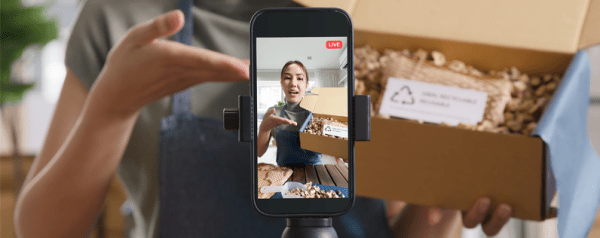
Despite the rise of newer social media channels like TikTok, Facebook remains the top social media platform, boasting 2.9 billion active users every month. And because of its popularity with users, it remains a smart place for businesses to advertise their products and services.
Facebook targeted ads for small businesses can be a game-changer if you want to improve your social media presence.
Posting content on Facebook is great, but Facebook ad targeting lets you reach a different audience than your Facebook business page alone. Knowing how to scale Facebook ads and use Facebook targeting strategies can help you generate new website traffic, nurture leads, and build your business.
What are Facebook targeted ads?
Facebook targeted ads are just what they sound like: Facebook ads that are targeted to reach the audience most likely to engage with them.
While Facebook has its own algorithms for showing ads to the best audience, ad creators can improve Facebook targeting by establishing who their target audience is and setting rules for who their advertisements should be directed.
What changed for Facebook targeted ads in 2022
Although Facebook’s personalized ads have been around for many years, Meta (Facebook’s parent company) made changes in 2022 that impacted how these ads work.
Specifically, Meta has removed Facebook ad targeting across four main categories: health causes, sexual orientation, religious practices and groups, and political beliefs.
Removing these categories from Facebook targeting reduced the opportunity for ads to be used in a targeted, hateful way. But it may make Facebook targeted ads for small businesses harder for certain industries. For example, small businesses that sell homeopathic medicines may have a more challenging time reaching their targeted audience.
Understanding Facebook’s special ad categories and unique targeting techniques can help your business continue to reach a personalized audience without targeting these specific groups.
Why your small business should be using Facebook targeted ads
Facebook targeted ads for small businesses make sense because targeting your ads to be shown to a niche audience increases the chances that the people who view your ads will be the types of leads you want to nurture.
As a result, your advertising budget can take you further than it otherwise could. That’s why Facebook ads for nonprofits work so well. Like small businesses, nonprofits need advertising techniques that will stretch their budget as far as possible. Fb targeted ads are a perfect tool for companies looking to meet that goal.
Another reason to target Facebook ads is to improve your omnichannel customer engagement strategy. With 81% of adults owning Facebook accounts, Facebook provides your small business with an extra touchpoint between you and most of your customers.
9 Facebook ad targeting strategies for small businesses
There are several ways to use Facebook targeted ads for small businesses. The key to making this work for your unique business is to understand a variety of strategies and then implement the ones that make the most sense for your specific business and your specific advertising campaign.
One way to do this is to establish a core audience for your ads. For example, if you want your ads to always go out to people in the United States, you could use geographic data to establish a local core audience.
But audience targeting can be much more precise than establishing your core audience. To that end, I’ve curated a list of nine strategies for using Facebook targeted ads for small businesses.
1. Use different types of ads
Facebook has several special ad categories — including image ads, video ads, carousel ads, and collection ads — which can provide different experiences for your users. By using a variety of different types of ads, your small business can stand out from your competitors. Your audience won’t get used to seeing your ads and scroll past them; each advertisement will feel like a new experience with your brand.
Facebook image ads and video ads are both what they sound like. Image ads rely on a combination of images and text, while video ads use a combination of videos and text. Both of these visual advertising techniques can be powerful. After all, Facebook posts with images receive twice the engagement as text-based posts alone. And video content is even better, with 74% of marketers agreeing that video content has better engagement than static image content.
Carousel ads take the idea behind image or video ads to the next level. They work similarly to a slideshow, allowing your business to feature up to 10 images or videos in a single advertisement. Carousel ads can be great for certain things, like a showcase for a gallery or a snapshot of a recent event that your business attended. But they can be overused and should be reserved for specific occasions.

The one downside to Carousel ads is that they can be distracting. Static images or videos may be more appropriate if you’re trying to tell a specific story or create a clear call to action (CTA).
Finally, collection ads are best for businesses looking to advertise their products. They allow users to browse a catalog of items in a collection without having to leave Facebook itself. These ads are great for leads who are close to the decision-making stage in the buying process.
2. Develop a custom audience
Facebook custom audiences are a collection of leads who already have a relationship with your business. This might include previous customers, people who have engaged previously with your ads, or people who have indicated an interest in your company.
Custom audiences are built off of “identifiers.” These might include the names or email addresses of people who currently have a relationship with your brand.
Custom audiences are a great way to nurture existing leads and move them further along your business’s sales funnel. You can also combine custom audiences with special types of advertisements for unique results.
For example, you could combine a custom audience of people who have looked at particular products recently with a collections advertisement featuring those products. While this type of advertising takes extra work, it also provides the personalized experience most customers prefer.
But the real power of developing a custom audience comes from using that custom audience to develop a lookalike audience.
3. Create a lookalike audience
Lookalike audiences are created based on your business’s custom audience.
Once you’ve created your custom audience, you can select a lookalike audience based on that custom audience. Facebook will then segment users based on criteria that make them look similar to your initial custom audience.
Lookalike audiences are a powerful tool with many applications. For example, when you consider how to grow your email list with Facebook, one potential strategy would be to create a lookalike audience based on a list of your current email subscribers.
Lookalike audiences can also be a quick and easy way to find potential leads, especially if you are not exactly sure who your target audience is. Instead of guessing who might be interested in your product, you can allow Facebook to deduce that information based on a list of your current customers.
4. Target your competitors’ audiences
There are several reasons to target your competitors’ audiences on Facebook. For one thing, competitors ranking higher than you in social media may have access to an audience you haven’t tapped into yet. Targeting their audience can give you access to new leads.
Suppose your product is better than the product your competitor has. In that case, you also have the potential to pull customers away from your competitor’s company and make them loyal to your company instead.
To target your competitors’ audiences, the first step is to identify who your competitors are. For example, a real estate company might look at a number of real estate Facebook ad examples to determine which real estate agents are most similar to them.
Keep in mind that your brand has both direct and indirect competitors. Direct competitors sell the same types of products or services that you sell. But indirect competitors have a similar target audience and could be just as useful for Facebook targeting strategies as direct competitors. For example, if your company sells yoga mats, a wellness spa could be considered a “competitor” for a target audience that cares about a wellness mentality.
Once you’ve identified your target audience, you can identify your competitor as an “interest” when setting up your targeted Facebook ads. This will tell Facebook to advertise to any customers who have shown an interest in your competitor’s company, either on Facebook or Instagram, as Meta owns both platforms.
5. Target specific life events
There are times in a customer’s life when they are more likely to make a purchase. For example, a soon-to-be-mother might be easier to persuade to buy a stroller than someone who already has three kids.
Life event triggering can help you show the right ads to people at these unique stages in their lives. Not only can you show your products to audience members who are at the right stage in their sales funnels, but you can also frame those products in a way that makes your audience feel some sort of emotion.
An advertisement with a ring in it is great. An ad showing two people walking down the aisle, directed to someone who has already proven themselves to be close to marriage, is even better.
Facebook already encourages users to declare life events on their profile pages. Users tell the world when they’ve gotten engaged, married, or had a child. So it becomes relatively easy for Facebook to use that information to help brands advertise to the right people at the right time.

It’s a good idea to look through the specific life events Facebook can target. Some life events, like spending time away from family, are unexpected but can be helpful for your brand. For example, holiday-themed advertisements may target the emotions of people currently away from their families.
6. Uncover recent purchasing behavior
A customer’s recent purchasing behavior can give you insights into their tastes. You can also personalize ads based on how customers have behaved in the past.
Of course, creating a custom audience lets you do this based on a customer’s purchases with your brand. For example, someone who just bought a cute skater dress might be interested in a new pair of leggings to go with the dress. You could determine that based on their purchase history with your store and create a custom leggings advertisement that only went out to people who had recently purchased dresses.
But Facebook’s purchasing behavior segmentation takes this even further, giving you access to buying behavior not just outside your company but outside your industry as well.

Facebook offers a wide array of categories of purchase behavior to choose from, including clothing, health and beauty, household products, and more. By delving into those categories, you can advertise products that complement purchases people have already made.
7. Target recent Facebook shoppers
In the same vein as targeting Facebook shoppers who have purchased certain items, you can also target Facebook shoppers who have recently purchased any items from Facebook.
There are a number of reasons to target recent Facebook shoppers. People who have made purchases recently may be more likely than others to have disposable income, for example. Or they may be gearing up for something like a birthday or holiday, in which case they may be on the lookout for more gift ideas.
People who have shopped from Facebook advertisements recently may also be more likely to be paying attention to ads or more prone to impulse shopping than people who have never purchased off of Facebook or who haven’t purchased from Facebook in a long time.
8. Look into layered targeting
Layered targeting takes some of the top Facebook targeting strategies we’ve already discussed and combines them in nuanced ways for expert audience segmentation.
The goal of layered targeting is to save your advertisements so that they only go to people who are the most likely to take action.
Imagine, for example, a small business that specializes in selling skate shoes. They could advertise specifically to people who have bought shoes in the past, but that could include just about anyone. They could also advertise to people who have listed skateboarding as an interest, but that might include teenagers who have never had to buy their own shoes because their parents still make purchases for them.
With layered targeting, a brand can instead target someone who has purchased shoes recently, has shown an interest in skateboarding, lives locally, is within a certain age bracket, has made purchases on Facebook in the past, and is similar to your current email subscribers.
Suddenly, the list of people seeing your advertisements is much narrower — and the chances of advertisement viewers being the types of people who will purchase your product are much higher.
9. Don’t forget to exclude people
In most aspects of life, excluding people is considered unkind. But when it comes to creating razor-sharp Facebook targeted ads for small businesses, knowing who to exclude and how to exclude them is just as important as knowing who to include.

For example, if you’re trying to sell a car seat, it’s a reasonably safe bet to exclude anyone who has recently purchased a car seat. Car seats are a product that parents usually do their research on, and once they’ve made a purchase, they typically don’t need another one any time soon.
Excluding people because they don’t meet your criteria — because they don’t live in your area, for example, or because they identify as vegetarian and you sell meat — means you’re not paying to advertise to people who are almost definitely not going to buy your product anyway.
Use Facebook targeted ads for small businesses to take your marketing to the next level
Using Facebook targeted ads for small businesses can help you stretch your advertising budget further while nurturing new and existing leads. Implementing a variety of advertising types and targeting niche audiences can help you showcase the best parts of your business to the right people.
Get started today by establishing a Facebook advertising budget. Then, create an advertisement that tells a story. Consider the audience that is most likely to benefit from hearing that story and brainstorm ways you can ensure that your target audience is the recipient of your advertising campaign.




